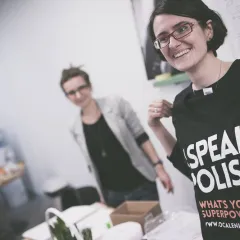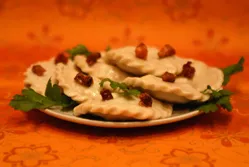Each culture has many dimensions which, in turn, can have all sorts of aspects. Apart from dances and binges, clothing and costumes, beliefs and rituals, there is also a culinary culture. It is widely known, that almost every country, region, local community, even villages have their characteristic dishes and a variety of specific traits. An example of typical eastern culinary culture, including the 'achievements of Ukrainian cooking techniques' are warenyki - pierogi ruskie - as they are called in Polish. Allegedly, pierogi were brought to Poland in the thirtheenth century by bishop Saint Hyacinth who tried them during his stay in Kiev, and became enraptured by their taste. Today, these dumplings are served in all cafeterias in Warsaw, where one can also savour the traditional Ukrainian borshch.
So, pierogi can be viewed on the macro level, because they are generally available, but also in micro scale - analysing the recipies of the so-called salo used in those two neighbouring countries. They may differ from one another in the way of preparation and taste, as one party will make them spicy, the other sweet. It is then, when handcraft, art, and even artwork occurs. From this point the culinary journey through Warsaw Ukraine begins ...
Pierogi - a work of art?
One may be amazed by this question - because how can a dish be compared with a masterpiece? But in this case, we can liken or equate cuisine with art. Although the above mentioned dumplings are associated rather with a kind of idyll, village and plump peasant kneading dough in the hut, they are refined and sophisticated dish, and under no circumstances can we consider them as kitschy disco polo. The so-called fast food dishes would rather deserved this title, while Warenyki may be culinary conterparts of Mozart's music, or van Gogh's paintings.. It's like Ferrari among the cars. It is a theatre, it is like Shakespeare's drama, the tragedy, the despair felt after losing warenyka can be observed in most bars in Warsaw Prague district or Krakowskie Przedmiescie Street. For when they run out of warenyki, the pea soup is all that's left ...
Culinary smuggling
For many foreigners, and for Polish citizens living in different parts of the country, Warsaw is Mecca of a kind.One that, despite your torment, makes you leave your children and family in Ukraine...
On the other hand, the pain means money. Unofficial reports state that there are up to 100, 000 Ukrainians who came to Warsaw in search of work. There are some who came to the capital of Poland not only to work but to study. Many a time they settle here after graduation. There is a young girl among them, who two years ago came here from the south-east Poland to earn her bread. She came for bread but has not forgotten about warenyki. So, when she visits her family, their kitchen turns into a factory. A group of her friend fans of the home made Ukrainian dumplings - await for the specialties. Once, however, the border guard (the girl lives in the Polish-Ukrainian border area) stopped the bus going to Warsaw. The view of a suitcase half-filled with warenyki startled officers, yet, they quickly regained their composure and began implementing the existing procedures, in accordance with the EU laws. Sometimes, inasmuch as we might try, we have no bearing on the situation we find ourselves in. Therefore, the whole range of concocted explanations did not work. Arguments like 'Kiev Warsaw - common cause', the good-neighbourly Polish-Ukrainian cooperation and cultural as well as culinary exchange between them should be developed, even justification that bigos and warenyki are like cousins failed. Firstly, because in this case there were too many warenykas and, secondly, it was too long a journey to Warsaw palates for such a work of art.
Savoir vivre and globalisation?
Since the national cuisine is also a cultural element, then we can say that eating culture is also culture.
Well-known Polish rock guitarist, a singer and a poet, graduate of vocational school for fitter-welders - Maciej Malenczuk - in one of his songs sings about 'set of labels and shoddy conventions'. It is known that the Polish code of conduct at the table does not allow belching during the meals, but for example, slurping and belching at the table in other countries - not only China, but in some countries of Western Europe, is now regarded as evidence that the meals consumed were tasty.
And how does this table culture - which is a set of savoir-vivre rules and etiquette indications, but also a kind of culinary culture looks like in Ukraine? Here, I will focus on just one old saying, most probably known by each fan of 'cultural elevation, flights, escapades, and voyages' in the east culture: It does not matter what you drink, but it is important what you nibble at!’
An example of cultural mixture are, or perhaps once were (ie, even 5 years ago), Warsaw shops called Smyki, and Student House on the Smyczkowa Street. An opportunity to produce such a cultural mix, where in one kitchen Ukrainian was heating up pierogi, Pole cooked bigos, while Mongol was adding rancid milk to some dish (which gave a specific repulsive smell; in Mongolia such butter is added even to tea), was due to the proximity of two buildings the dormitory and the nearby Faculty of East Slavonic Philology.
It is known that one day (in Poland in the eighteenth century) 'a memorable moment has cometh' and everyone started using the benefits of technology - forks. But where to put a fork? As among students,' there is time to have fun but also... to have fun At this point, a typical intercultural alcohol drinking in the backyard comes to mind. and where is your food?- Ukrainian students were surprised when it turned out that none of their Polish peers was eating (I think the concept of eating while drinking alcohol called in Polish 'zakąszanie'' - does not need any further comments). We can say that students are poor and cannot afford to waste money on food, but, on the other hand, all students are the same, aren't they?
This is the eating culture, or drinking techniques that matter here. Then, the students began negotiations, Polish students tried to convince their Ukrainian peers that they did not do so, because it is beyond their imagination to walk around the city with grilled chickens and cucumbers in their pockets, while the Ukrainians, well ... One can see what role the Western culture has played in Poland after the 90's, and how coca cola to some extent replaced the proverbial herring, and Polish variation of black pudding served on a newspaper, etc.
First, the no 25, and then ...
In one of Warsaw restaurants I stumbled upon 'Days of Ukrainian cuisine'. There were two students there who found an item called 'deruny' in the menu. Having learned that these are potato pancakes (it is possible that in Ukraine, Russia, and Belarus they are differently served) they came to a conclusion that they are too expensive, so they would order a pizza. As you can see 'Days ...' is a good way of making business, since it is one of that kind in the city.
Coming back to the menu! Among the many dishes of Ukrainian cuisine, traditionally based on flour and groats, as well as meat and vegetables, including various types of warenyki, borshch, blini (pancakes) or deruni, I of course gave in to the temptation of trying salo (in Poland called slonina pork fat). It is one of the elements of traditional Ukrainian cuisine and also the favourite national dish, which is served in every conceivable form - salted, smoked, stewed, sweet (salo in chocolate). Most often it is eaten with bread and mustard (the traditional kinds are: 'Devil' and 'Cossack') and with potatoes. In the past, salo was eaten due to the high calorie content, today is more favoured for its taste.
Coming across 'Days of Ukrainian cuisine' I could not resist ordering it because it was probably the only chance to get hold of this delicacy in Warsaw. However, I could not buy the Ukrainian beer, because it was not included in the menu.
I was immediately advised that Ukrainian beer, for example, the perce horilka with mead is now available in almost every Warsaw shop and bar, but it will be the easiest to go to restaurant Babooshka (this Russian restaurant in Warsaw also serves Ukrainian dishes):
- Just take a tram 25 to the downtown...
- Except that - there is no salo there!
It is a pity that when only once a year we have the opportunity to try this Ukrainian specialty and we also want to drink Ukrainian beer we must choose between them.
This is confirmed by the words of a journalist from one of Warsaw dailies, who "remembering the taste of Ruthenian delicacies, cannot understand why the city does not have any Ukrainian restaurant? '.
A hot dog for cold
Winter is approaching, so I will go to 'знайомого', he will take out the homemade salo, we will drink tcharotchkoy, and I will enjoy the view of people flocking to a hot dog booth open 24/7. Well, maybe it tastes good to someone, maybe someone likes it.
A matter of taste, even though, to a certain extent it is linked with culture, including the culinary issues. So up to you, to us and to those in queuing in front of the stall!
Text by Paweł Łoza (пл)
Translated by Pola Rutkowska










